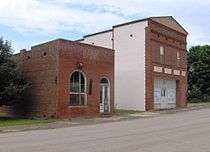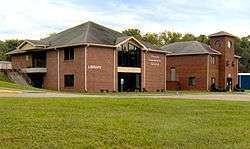Vonore, Tennessee
| Vonore, Tennessee | |
|---|---|
| Town | |
|
Community center and city hall in Vonore | |
|
Location of Vonore, Tennessee | |
| Coordinates: 35°35′58″N 84°13′22″W / 35.59944°N 84.22278°WCoordinates: 35°35′58″N 84°13′22″W / 35.59944°N 84.22278°W | |
| Country | United States |
| State | Tennessee |
| Counties | Monroe, Blount |
| Established | 1890s[1] |
| Incorporated | 1965[2] |
| Named for | Combination of von and ore[1] |
| Area | |
| • Total | 11.9 sq mi (30.9 km2) |
| • Land | 9.0 sq mi (23.3 km2) |
| • Water | 2.9 sq mi (7.6 km2) |
| Elevation | 860 ft (262 m) |
| Population (2010) | |
| • Total | 1,474 |
| • Density | 164/sq mi (63.3/km2) |
| Time zone | Eastern (EST) (UTC-5) |
| • Summer (DST) | EDT (UTC-4) |
| ZIP code | 37885 |
| Area code(s) | 423 |
| FIPS code | 47-77480[3] |
| GNIS feature ID | 1273493[4] |
Vonore is a town in Monroe and Blount counties in the U.S. state of Tennessee. The population was 1,474 as of the 2010 census.[5]
History
Vonore's location at the confluence of the Little Tennessee River and the Tellico River places it near the center of one of the richest archaeological regions in the southeastern United States. The now-submerged Icehouse Bottom site was occupied by Native Americans as early as 7500 B.C., and the now-submerged Rose Island was home to a significant Woodland period (c. 1000 B.C. – 1000 A.D.) settlement. A substantial Mississippian period (c. 1000–1600 A.D.) village was located at Toqua, immediately south of Vonore. There is some evidence that Toqua's Mississippian village was the village of "Tali", visited by the Hernando de Soto expedition in 1540.[6]

By the time Euro-American explorers arrived in the area in the 18th century, the Overhill Cherokee had established several villages along the Little Tennessee. These villages included Tanasi, the name source for the state of Tennessee, and Chota, the "mother town" of the Overhills. Mialoquo, the home of the Cherokee chief Dragging Canoe, was located just north of the modern US-411 bridge. Tuskegee, which developed adjacent to Fort Loudoun, was the birthplace of Sequoyah, creator of the written Cherokee syllabary.[6]
Fort Loudoun was a British colonial-era fort built in 1756 in hopes of obtaining Cherokee assistance during the French and Indian War. It was one of the first major British outposts west of the Appalachian Mountains, though it was only garrisoned until 1760, when the Cherokee captured it after a lengthy siege.[7] The Tellico Blockhouse, an American outpost located across the river from Fort Loudoun, was built in 1794 to help keep the peace between the Cherokee and the fast-encroaching American settlers. The Tellico agent, the chief American diplomat to the Cherokee, operated out of the blockhouse.
In 1819, the Cherokee signed the Calhoun Treaty, relinquishing what is now Monroe County to the United States. The county itself was established shortly thereafter. Niles Ferry, the primary crossing of the Little Tennessee River along the Old Federal Road (which roughly followed modern US-411), operated at what is now the US-411 bridge from 1805 to 1947. The ferry was established by early settler Barclay McGhee, who had leased the rights from the Tellico agent. Barclay McGhee operated the ferry until his death in 1819. It would eventually come under the ownership of McGhee's son, John McGhee. The ferry is named for J.W.J. Niles, a son-in-law of John McGhee who assumed ownership of the ferry in the 1850s.[8]
In 1890, the Atlanta, Knoxville and Northern Railroad laid tracks through Monroe County. A stopover known as Upton Station was established just beyond the railroad's Little Tennessee River crossing. Three years later, an area doctor named Walter Kennedy applied for a post office for Upton Station. When the postal service informed him that Upton Station had been taken, Kennedy chose the name "Vonore", a combination of the German word von (meaning "of") and the English word "ore", as Kennedy believed the town would become a mining town.[1]
Most of the valley's archaeological sites were flooded in 1979 when the Tennessee Valley Authority completed Tellico Dam at the mouth of the Little Tennessee. Preservationists aided by Works Progress Administration (WPA) funds had reconstructed Fort Loudoun in the 1930s. Additional reconstruction was undertaken in the 1970s and 1980s, including moving the fort out of range of water which the dam would raise. After archaeological excavators located the foundation of the Tellico Blockhouse in the 1970s, they placed posts and fill to give visitors an idea of its layout. Both are now part of Fort Loudoun State Park.
Geography
Vonore is located along the northern border of Monroe County at 35°35′58″N 84°13′22″W / 35.59944°N 84.22278°W (35.599309, -84.222771).[9] A small portion extends into Blount County along Ninemile Creek. Vonore is situated primarily along the southwestern bank of the Little Tennessee River at its confluence with the Tellico River. This section of the Little Tennessee and the lower Tellico River are both part of Tellico Lake, an artificial reservoir created by Tellico Dam. The Unicoi Mountains and Great Smoky Mountains rise prominently to the south.
According to the United States Census Bureau, the town has a total area of 11.9 square miles (30.9 km2), of which 9.0 square miles (23.3 km2) is land and 2.9 square miles (7.6 km2), or 24.67%, is water.[5]
U.S. Route 411 connects Vonore with Maryville to the northeast and Madisonville to the southwest. Tennessee State Route 72 connects the town with Tellico Village, Loudon, and Interstate 75 to the north. State Route 360 connects the town with Fort Loudoun State Park and the rural areas at the base of the mountains to the south. The older part of town is situated along Depot Street, and includes the town hall and other municipal buildings. A more modern retail corridor spans most of the Vonore section of US-411.
Demographics
| Historical population | |||
|---|---|---|---|
| Census | Pop. | %± | |
| 1970 | 524 | — | |
| 1980 | 528 | 0.8% | |
| 1990 | 605 | 14.6% | |
| 2000 | 1,162 | 92.1% | |
| 2010 | 1,474 | 26.9% | |
| Est. 2015 | 1,493 | [10] | 1.3% |
| Sources:[11][12] | |||
As of the census[3] of 2000, there were 1,162 people, 496 households, and 333 families residing in the town. The population density was 133.6 people per square mile (51.6/km²). There were 571 housing units at an average density of 65.6 per square mile (25.3/km²). The racial makeup of the town was 95.52% White, 0.17% African American, 0.26% Native American, 0.09% Asian, 0.69% from other races, and 3.27% from two or more races. Hispanic or Latino of any race were 2.58% of the population.

There were 496 households out of which 28.6% had children under the age of 18 living with them, 51.8% were married couples living together, 10.7% had a female householder with no husband present, and 32.7% were non-families. 27.6% of all households were made up of individuals and 13.5% had someone living alone who was 65 years of age or older. The average household size was 2.34 and the average family size was 2.82.
In the town the population was spread out with 23.4% under the age of 18, 7.8% from 18 to 24, 30.6% from 25 to 44, 23.1% from 45 to 64, and 15.1% who were 65 years of age or older. The median age was 36 years. For every 100 females there were 96.6 males. For every 100 females age 18 and over, there were 91.8 males.
The median income for a household in the town was $34,653, and the median income for a family was $41,125. Males had a median income of $31,429 versus $25,956 for females. The per capita income for the town was $19,613. About 6.1% of families and 10.5% of the population were below the poverty line, including 7.6% of those under age 18 and 13.2% of those age 65 or over.
Recreation
Vonore is located on the shores of Tellico Lake and is the location of two Tennessee State Historic Areas, Fort Loudoun State Historic Park and the Tellico Blockhouse State Historic Site. In addition, the Sequoyah Birthplace Museum, operated by the Eastern Band of Cherokee Indians, honors the life of the Cherokee scholar. Several swimming areas have been developed along the lake, including Vonore Beach along the lake's Creek Island Creek embayment near the center of town, and Toqua Beach just south of Fort Loudoun State Park. The Sequoyah Marina is located just off US-411, where the road crosses the lake.
Education
Public schools in Vonore are operated by the Monroe County School System, and include:
- Vonore Elementary School, Grades K-5
- Vonore Middle School, Grades 6-8
Vonore High School consolidated with Madisonville High School in 1995 to form Sequoyah High School in Madisonville.
Notable people
- Charles McClung McGhee, railroad baron and financier
- Sequoyah, Cherokee scholar
- Mike Stratton, NFL linebacker
References
- 1 2 3 "Origin of Vonore, Tennessee", Town Official Website, Retrieved: 31 July 2008.
- ↑ Tennessee Blue Book, 2005-2006, pp. 618-625.
- 1 2 "American FactFinder". United States Census Bureau. Retrieved 2008-01-31.
- ↑ "US Board on Geographic Names". United States Geological Survey. 2007-10-25. Retrieved 2008-01-31.
- 1 2 "Geographic Identifiers: 2010 Demographic Profile Data (G001): Vonore town, Tennessee". U.S. Census Bureau, American Factfinder. Retrieved April 9, 2014.
- 1 2 Jefferson Chapman, Tellico Archaeology: 12,000 Years of Native American History (Knoxville, Tenn.: Tennessee Valley Authority, 1985).
- ↑ Carroll Van West, "Fort Loudoun," Tennessee Encyclopedia of History and Culture. Retrieved: 23 February 2014.
- ↑ Benjamin C. Clark, Jr., "Cherokees, Roads and Land: The Early History of the Niles Ferry," Tennessee Ancestors, Vol. 28, No. 3 (December 2012), pp. 3-22.
- ↑ "US Gazetteer files: 2010, 2000, and 1990". United States Census Bureau. 2011-02-12. Retrieved 2011-04-23.
- ↑ "Annual Estimates of the Resident Population for Incorporated Places: April 1, 2010 to July 1, 2015". Retrieved July 2, 2016.
- ↑ "Census of Population and Housing: Decennial Censuses". United States Census Bureau. Retrieved 2012-03-04.
- ↑ "Incorporated Places and Minor Civil Divisions Datasets: Subcounty Resident Population Estimates: April 1, 2010 to July 1, 2012". Population Estimates. U.S. Census Bureau. Archived from the original on June 17, 2013. Retrieved 11 December 2013.
External links
- Municipal Technical Advisory Service entry for Vonore — information on local government, elections, and link to charter
